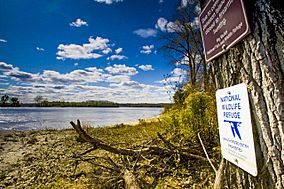Big Muddy National Fish and Wildlife Refuge facts for kids
Quick facts for kids Big Muddy National Fish and Wildlife Refuge |
|
|---|---|
|
IUCN Category IV (Habitat/Species Management Area)
|
|

Jameson Island unit of Big Muddy National Fish and Wildlife Refuge, October 2012
|
|
| Location | Missouri River, Missouri, United States |
| Nearest city | Jefferson City, Missouri |
| Area | 16,700 acres (68 km2) |
| Established | 1994 |
| Governing body | U.S. Fish and Wildlife Service |
| Website | Big Muddy National Fish and Wildlife Refuge |
The Big Muddy National Fish and Wildlife Refuge is a special place in Missouri. It was created in 1994 to protect nature. This refuge is made up of many smaller areas. These areas are spread out along the Missouri River between Kansas City and St. Louis. The refuge helps fish and wildlife that depend on the river's floodplain. It has grown to over 16,700 acres (67.6 km2). The plan is for it to grow even bigger, to 60,000 acres (240 km2)! This will happen by buying land from people who want to help wildlife.
Discover the Big Muddy Refuge
The Big Muddy Refuge is like a string of pearls. Each "pearl" is a piece of land along the Missouri River. These lands are important homes for many animals. They especially help creatures that live in areas near rivers that sometimes flood. The refuge aims to protect these important habitats.
The Missouri River: Past and Present
Long ago, the Missouri River was very different. Explorers Lewis and Clark described it as wide and slow. It had many shallow, braided channels. This created a perfect home for wildlife. There were huge forests, marshes, and wet prairies in the floodplain.
Today, the river has changed a lot. It is now "channelized." This means it has been made deeper and faster. Walls called levees and dikes control its flow. These changes help boats travel easily. They also make the land next to the river good for farming. But these changes also affect the natural homes of animals.
Helping the River Heal
The Big Muddy Refuge is working to bring back the river's natural ways. They want the Missouri River to flow into its floodplain again. This happens during small floods. To help, the refuge has created new side channels. They have also removed parts of levees. This allows the river to spread out naturally.
The refuge also lets the natural plants grow back. Right now, many parts of the refuge are thick with young trees and plants. As these trees grow, the refuge will change over time. This process will take many years, even centuries, to fully develop. It's a long-term project to help nature thrive.


